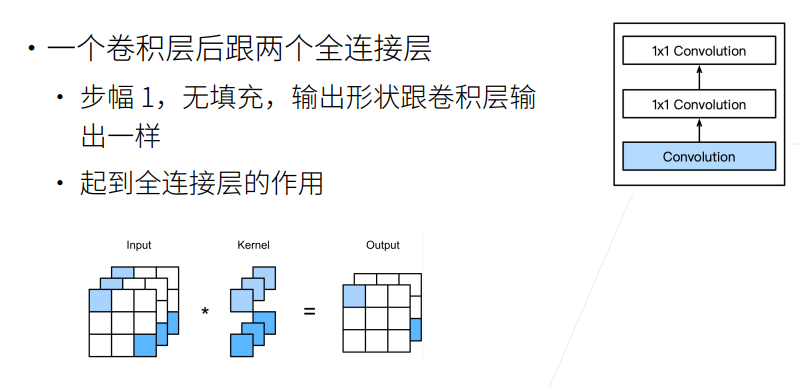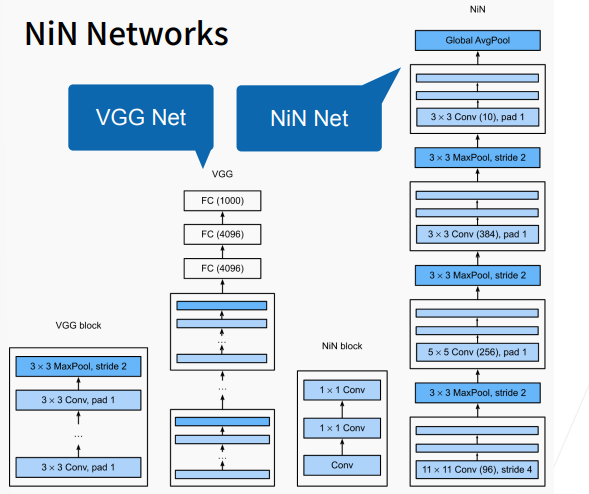26-NiN
26-网络中的网络(NiN)
1. 动机
全连接层的问题
- 卷积层需要的参数较少
- 而卷积层后的第一个全连接层的参数较多

以 VGG 为例(图示),全连接层需要先 Flatten,输入维度为 512x7x7,输出维度为 4096,则需要参数个数为 512x7x7x4096=102M。
2. NiN 块
- 核心思想:一个卷积层后面跟两个 1x1 的卷积层,后两层起到全连接层的作用。

3. NiN 架构
- 无全连接层
- 交替使用 NiN 块和步幅为 2 的最大池化层
- 逐步减小高宽和增大通道数
- 最后使用全局平均池化得到输出
- 其输入通道是类别数
4. NiN Networks

NiN 架构如上图右边所示,若干个 NiN 块(图示中为 4 个块)+池化层;前 3 个块后接最大池化层,最后一块连接一个全局平均池化层。
5. 总结
- NiN 块结构:使用卷积层加两个 1x1 卷积层
- 后者对每个像素增加了非线性性
- NiN 使用全局平均池化层来替代 VGG 和 AlexNet 中的全连接层
- 不容易过拟合,更少的参数个数
6.代码
# 如果在Colab上跑, 或没有安装过d2l包, 需要最开始pip install d2l
!pip install git+https://github.com/d2l-ai/d2l-zh@release # installing d2l
NiN 块
import torch
from torch import nn
from d2l import torch as d2l
# 定义NiN块
def nin_block(in_channels, out_channels, kernel_size, strides, padding):
return nn.Sequential(
nn.Conv2d(in_channels, out_channels, kernel_size, strides, padding),
nn.ReLU(), nn.Conv2d(out_channels, out_channels, kernel_size=1),
nn.ReLU(), nn.Conv2d(out_channels, out_channels, kernel_size=1),
nn.ReLU())
NiN 模型
net = nn.Sequential(
nin_block(1, 96, kernel_size=11, strides=4, padding=0),
nn.MaxPool2d(3, stride=2),
nin_block(96, 256, kernel_size=5, strides=1, padding=2),
nn.MaxPool2d(3, stride=2),
nin_block(256, 384, kernel_size=3, strides=1, padding=1),
nn.MaxPool2d(3, stride=2), nn.Dropout(0.5),
# 标签类别数是10
nin_block(384, 10, kernel_size=3, strides=1, padding=1),
nn.AdaptiveAvgPool2d((1, 1)), #全局平均池化,高宽都变成1
nn.Flatten()) #消掉最后两个维度, 变成(batch_size, 10)
demo 测试,查看每个块的输出情况
X = torch.rand(size=(1, 1, 224, 224))
for layer in net:
X = layer(X)
print(layer.__class__.__name__, 'output shape:\t', X.shape)
>>>
Sequential output shape: torch.Size([1, 96, 54, 54])
MaxPool2d output shape: torch.Size([1, 96, 26, 26])
Sequential output shape: torch.Size([1, 256, 26, 26])
MaxPool2d output shape: torch.Size([1, 256, 12, 12])
Sequential output shape: torch.Size([1, 384, 12, 12])
MaxPool2d output shape: torch.Size([1, 384, 5, 5])
Dropout output shape: torch.Size([1, 384, 5, 5])
Sequential output shape: torch.Size([1, 10, 5, 5])
AdaptiveAvgPool2d output shape: torch.Size([1, 10, 1, 1])
Flatten output shape: torch.Size([1, 10])
训练模型
lr, num_epochs, batch_size = 0.1, 10, 128
train_iter, test_iter = d2l.load_data_fashion_mnist(batch_size, resize=224)
d2l.train_ch6(net, train_iter, test_iter, num_epochs, lr, d2l.try_gpu())
>>> <Figure size 252x180 with 1 Axes>
